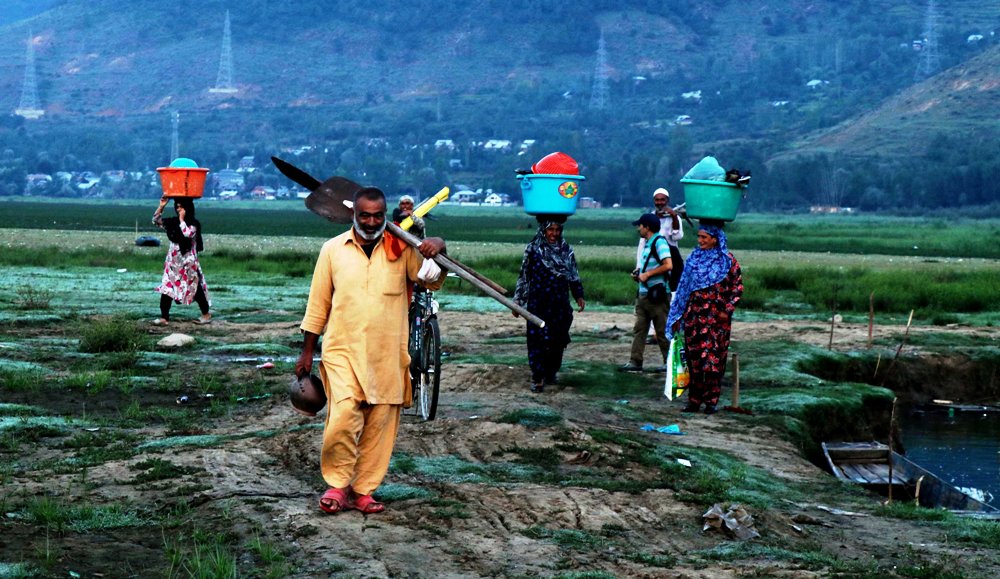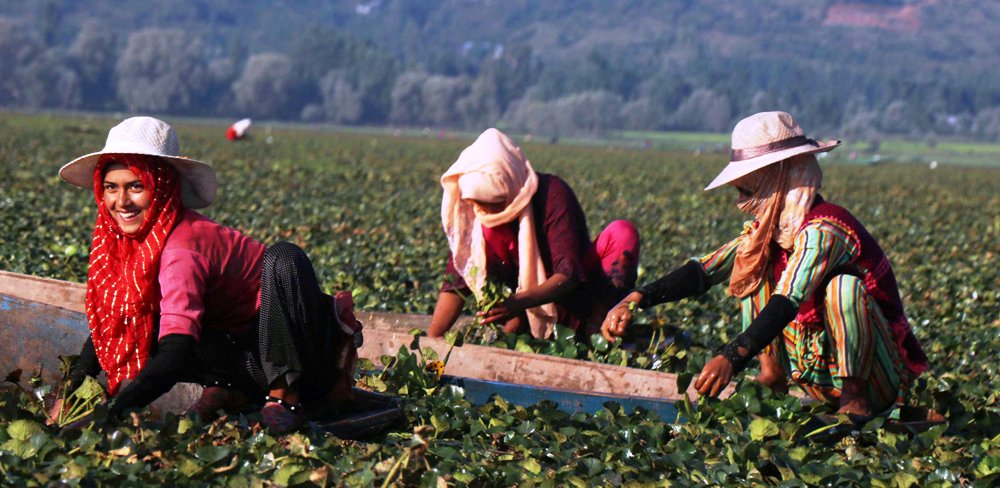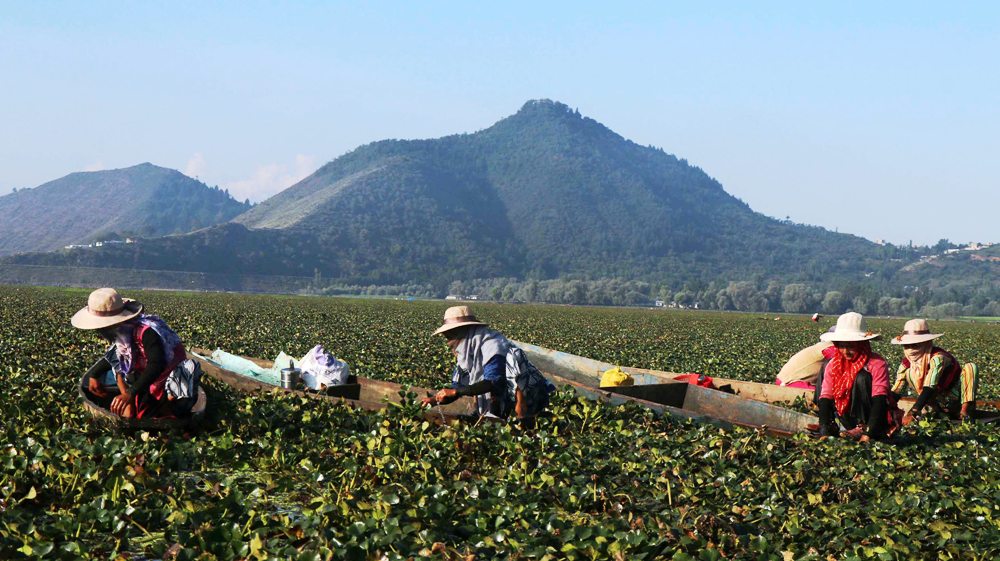Water chestnuts harvested from Wullar lake have helped Kashmir survive the worst days in the last 250 years. Considered the best food for diabetics, these nuts, unlike apple and saffron, have not been branded. This has resulted in traders making the best of it at the cost of harvesters. Mohammad Fazil Buchh spent days in the belt and argues for an intervention that must start with improving the lake first
It has multiple names. Locally known as Gaer, it is botanically called Trapa and water chestnuts by English. In Kashmir’s history, it has survived as Singhara, a nut that has always been associated with Vale’s misery. Till 1947, it was a despot’s currency and perhaps the only cheap food for a vast population including Srinagar’s Shawl-weavers. Once the situation improved, it represents the economic crisis in which tens of thousands of families living on Wullar Lake’s shoreline find themselves.
Fall in its growth notwithstanding, the water chestnuts continue to be the most accessible profession for a lot of fishermen people whose families spend most of the year harvesting, steaming, peeling, baking, crushing, winnowing, and then marketing them. A conservative estimation suggests around 50 per cent of the total vegetation around the Wular Lake, Kashmir’s first Ramsar Site, comprises water chestnuts.
Net Nut Business
Baniyar, Lankreshpora, Kanibathy, Ashtangoo and Zurmanz are the main villages which make Bandipora the largest producer of Kashmir chestnuts. These areas inhabiting the lake shoreline are licensed to harvest water chestnuts. Official estimates suggest that around 90 per cent of the total water chestnuts in Kashmir amount to around four metric tons of nuts every year.
Residents said around 80 per cent of inhabitants living around the Lake are involved in extracting chestnuts. Around 32000 families of 30 odd villages depend on Wular Lake for their livelihood. The socio-economic condition of most of these villages is quite distressing.
Baniyar village, which exclusively depends upon water chestnuts, is situated on the banks of river Jhelum. The village presents a grim picture of people living in sheds or Kutcha houses, some of them thatch-roofed. The sight of women washing clothes along river banks and children bathing in the river is a common sight.

The roads leading to Baniyar are dilapidated with heavy boulders and sharp-edged stones acting as a deterrent for vehicles to ply. However, there are a few Chestnut crushing units donning the sides around which women and children are seen carrying big-wooden baskets of dried chestnuts on their heads.
“The village comprises three mohallas; Watalpora, Bakerpora and Jadalpora, with 800 households – all relying on chestnuts,” Khadeeja Begum, Sarpanch of Baniyar, said. “The area is poverty stricken due to which our children have to drop out of schools. They help families in the chestnut business which fetches them a few pennies. The genuine rate we should receive is Rs 20,000 per quintal but we get only Rs 6000 to Rs 8000.”
She insists that the production has fallen. “Earlier, this village used to fetch around 600 kilograms per day. Our production was so surplus that we used to save some stock for next year,” Begum said. “Now the whole village is only able to collect 1000 quintals in the entire season.”
Mohammad Sultan is harvesting chestnuts for over 40 years.“There are around 50,000 fishermen who depend on the lake for their livelihood. Around 30,000 of them deal exclusively with chestnut while others are involved in fishing,” Sultan said. “We extract chestnuts in summers from July to September in which green chestnuts are plucked and then in winters from November to March in which fallen chestnuts are collected using nets.”
Residents demand that the entire area from Watlab to Lankreshpora should not require a license for harvesting as was done by former Prime Bakshi Minister Ghulam Mohammad. The license-free areas are locally known as Dharam. Those areas required to pay annually to the government for a license are called Yampar.
Sultan believes that a fisherman earns around Rs 10,000 from the chestnut business in a month. “Families having more manpower earn better,” he said, insisting the harvesting is labour-intensive. The more people in the lake the more nuts they extract. “We sell green chestnuts to the local customers who like them more. These are also costlier than the winter chestnuts, the Kame Gaer.” Kame Gaer is produced in bulk, are in demand in dried form during winters outside Kashmir.
“We sell our harvest to local traders who supply it to outside markets,” Sultan said. “It is the traders who get a good return and not the harvester. We still thank God for providing us with this treasure which at least helps us survive.”
Baniyar resident, Abdul Razaq, 60, has shifted from being a water chestnut harvester to a water chestnut trader after 30 years due the lucrative nature of the latter. He purchases around 400 quintals of chestnuts each season and then sells them to the chestnut dealers in Hajin. The dealers then supply the produce to other states in India. Along with Razaq, there are five traders in Baniyar while the rest of the 600 households are engaged in extraction.

The Chest nut rates are higher during the Hindu festivals of Navratri and Shivratri. “They (Hindus) make Puris from the chestnut flour, use it in Pakoras and also consume it in dried form,” one trader said. “Dried chestnuts aren’t preferred in Kashmir. Apart from cart vendors, nobody sells dried chestnuts here. A minuscule number of diabetic people consume dried chestnuts in Kashmir.”
Trading chestnuts have an element of risk. “If the prices fall, we bear the brunt,” Razak said. “IF the prices are better, we earn ten times that of the harvester.”
Women on Forefront
The winter chestnuts, collected from October to February, are mainly collected by the men folk. Women are the main labour force behind the processing of the final product. Chestnuts are collected using a Kashop (net), which is thrown into the bottom of the lake, dragged around and then brought up.
“During Chillai Kalan, our men leave just after pre-dawn Fajr prayers to collect water chestnuts using nets,” Mohammadi Begum, an elderly Baniyar lady, said. “They row boats in frozen waters amid bone-chilling cold and winds. The process of collecting water chestnuts in winter from the base of Wular takes a few months. By the end of the harvesting season, the produce is brought home and processed.”
The chestnuts collected in winter are mainly of two types. The peeled water chestnuts (Gaer Goji) and crushed nuts (Gaer). Women wear a thumb ring along with a traditional wooden knife to peel the extract.

Another dried chestnut, known as Singhara in Hindi, often causes injuries to women workers because of its thorns resembling a buffalo’s horn.
These peeled chestnuts are then directly sold in the main markets of Bandipora where women sit along roadsides and mosques. A kilogram of nuts fetches them around Rs 100.
Traditionally, the chestnuts, after smoking, are grounded into pieces to form Gaer. It required a traditional crusher Indermohul, which was operated by three people. Indermohul has now been taken over by a mechanical crusher. Women take crushed nuts home for the winnowing process (Gaer Tchathin). The shells collected from the winnowing process are then stored for use in Kangris (fire pots) as fuel.
The processing takes a toll on the health of the women involved in the activity. “Our health deteriorates. We develop blisters on fingers and our legs are severely bruised,” Mohammadi Begum said. “Due to the winnowing process, our faces and clothes turn black because of the smoke. Only God knows how much money would be needed for our treatment if we go to a doctor someday.”
Begum said they lack an alternative. “I have spent my entire life fetching and processing water chestnuts and even today, when I am old, I do not have time to rest,” she said.
A Grilling Routine
Aisha, 45, a resident of Kanibathy, starts her day at Fajr time. She prepares breakfast for her family while her two daughters pack lunch for their parents. Aisha, with her husband, then leaves for the lake. At the lake, the husband and wife sail in two separate boats. She collects Athe Gaer while he goes fishing.

Even after toiling work, Aisha’s family fails to make ends meet. “We work three-quarters of a day in the scorching heat only to collect two baskets of chestnuts. We earn only Rs 6000 for one quintal of chestnuts which is very less given the hard work we put in,” Aisha said. “It takes a heavy toll on our health as we have to sit still in one position for long hours in a boat. We suffer from severe pain in the back and legs.”
Shama, 46, a widow from Baniyar took it upon herself to collect and process the chestnuts after losing her husband five years ago. She now takes care of her two daughters and a son and earns for them.
Until a few years ago, she was able to fetch a good quantity of chestnuts to fulfil her needs. Now, she says that quantity has significantly gone down forcing her son to drop out of school. Her two daughters never went to school. The children help her mother in collecting and sell the produce in the market.
“This year we were able to fetch only a few kilograms of chestnuts after working for long hours in the scorching heat. This will earn us a meagre amount of money not sufficient to cater to even our basic requirements,” she asserted.
Pollution Anxieties
The pollution in the Lake is making the chestnut collectors anxious as their production is dwindling. The lake’s large catchment area has added to its woes as the plastic waste is drained by Jhelum into the lake. It has badly impacted the quality of chestnuts. The colour and texture of nuts have changed. The significant decrease in the water level is also a reason for the low yield of chestnuts. The floating plastic bottles, diapers and polythenes are a common sight in the lake leading inhabitants to desist from getting involved in the chestnut business.

“This lake is our home. We drink water from it, wash clothes in it, bathe in it and most importantly earn from it. We demand the government preserve the lake for future generations. We want the pollution influx to stop. A large portion of the lake is already destroyed,” Abdul Ahad, 55, said in Kanibathy. “The maximum depth of Wular used to be 25 feet but now it is hardly 5 feet. Wular is dying and with this fish and Singhara are also decreasing. We used to collect Nadru in abundance until a few years ago but now it has vanished from the lake.”
Locals claim that the sand mining in Jhelum has also decreased the water level of Wular. They claim that the increase in depth of the Jhelum in the outflow channel leads to a quick discharge of the lake.
“Recently two new machines have been employed near Sopore for sand extraction,” Ali Mohammad, a fisherman revealed. “This exercise has destroyed Wular. Wular project near Suderkote has helped in the restoration of the lake but attention should be paid towards the catchment areas near Baramulla and Sopore where fear of water loss of the lake is more.”
Ali said they have heard a lot from the government about dredging and stopping the plastic inflow into the lake. “Nothing concrete has been done so far. Nobody pays heed to our issues. We are poor people who rely on this lake for livelihood. If it dies, we will die.”
One of the main contributors to the pollution of the lake is the vast plantation. As per a report, 27 sq km of willow plantation in the lake has heavily silted it. The waste of the willow has also settled in the lake leading to shrinkage. Another pollutant is the lake being turned into a dumping site, which is now being cleared by the government to reclaim the lake’s area. The level of nitrogen and phosphorous in the lake has also increased due to plastic waste.
The Conservation Project
Dr Ather Masoodi, an independent Consulting Wetland Ecologist said that since most of Kashmir is settled on the banks of river Jhelum and most of the solid waste, carcasses and plastic are ultimately dumped into the river which drains into the lake.
This, he said, has resulted in a decrease in the expanse of the lake along with the decline in its water-holding capacity. “This has a negative impact on the functioning of the Lake and the services this eco-system provides. There is an urgent need to prevent the solid waste from flowing into the lake.”
Another major reason for the deterioration of the Wular is siltation which has been going on for over a century now. Wular management authorities have been trying to address the issue of plantation in the lake.
Dr Masoodi said that under a Ministry of Environment study they were asked whether removing 2.1 million trees in the Wular would be an economically viable decision.“In our report, we strongly recommended that the willow plantation in the lake must be removed. We have provided numbers which suggest its economic viability. It will increase the water holding capacity in the lake as well.”
The Wular Conservation Project was started a few years ago but the wetland experts opine that effective monitoring is pivotal for its success.

“Whenever we try to make interventions in an ecosystem, monitoring is very important. There is a need to involve wetland experts. Wetland management is a specialized science. It is challenging for the forest people to understand the lake ecosystem unless they involve the people who have been studying the ecology of this lake,” Dr Masoodi asserts. “Taking local people and all the stakeholders into confidence is essential. There should be a holistic approach. It will enable authorities to achieve better results as far as the restoration of the lake is concerned.”
The government has been desilting catchment areas of the lake. To date, 4.7 km have been restored. As per government figures, around one lakh, willow trees have been axed which is just a minuscule of the tall order they have.
No Chestnuts
The compromised economy is impacting the new generation. The literacy rate in the areas is very low owing to the students dropping out of school to help their poverty-stricken families in the chestnut business. There are schools from primary to high school level in the villages. The total enrolled students in all the schools are around 800. Students do not go to school punctually during the chestnut harvesting season.
Mohammad Ashraf, a local school teacher from Bakerpora informed they conducted a survey in April this year, in which 50 students have dropped out from two local schools in the last few years.
“When we approached these students to motivate them to continue their education, we got to know that they have already got into the chestnut business chain at some level. Some have even become sand mining labourers. The poor economic condition of the families doesn’t allow the children to continue their studies,” Ashraf said.

The boy versus girl student ratio in the areas is also low with girls being enrolled in lesser numbers.
“Last year a middle school in a nearby village was upgraded to a high school in which the first matriculation examination was held. All the 20 local students who appeared qualified. However, sadly, only a few of them pursued further studies,” the teacher said.
There are more than 20 graduates and a few post-graduates in the area. But they too have picked up chestnut extraction or sand mining because of the unemployment.
“New generation is hesitant in extracting chestnuts. They instead prefer to work as sand mining labourers. If provided a fair chance, they can really prove their mettle in the field of education. Four years ago, a boy namely Waseem qualified medical entrance test from the area. He was the first from the area and is currently pursuing MBBS from the Government Medical College in Srinagar. It was a proud moment for the whole area,” Ashraf said with hope for the younger generations of these areas to throng schools.















